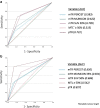Metabolic tumour and nodal response to neoadjuvant chemotherapy on FDG PET-CT as a predictor of pathological response and survival in patients with oesophageal adenocarcinoma
- PMID: 36920518
- PMCID: PMC10121512
- DOI: 10.1007/s00330-023-09482-7
Metabolic tumour and nodal response to neoadjuvant chemotherapy on FDG PET-CT as a predictor of pathological response and survival in patients with oesophageal adenocarcinoma
Abstract
Objectives: 2-deoxy-2[18F]Fluoro-D-glucose (FDG) PET-CT has an emerging role in assessing response to neoadjuvant therapy in oesophageal cancer. This study evaluated FDG PET-CT in predicting pathological tumour response (pTR), pathological nodal response (pNR) and survival.
Methods: Cohort study of 75 patients with oesophageal or oesophago-gastric junction (GOJ) adenocarcinoma treated with neoadjuvant chemotherapy then surgery at Guy's and St Thomas' NHS Foundation Trust, London (2017-2020). Standardised uptake value (SUV) metrics on pre- and post-treatment FDG PET-CT in the primary tumour (mTR) and loco-regional lymph nodes (mNR) were derived. Optimum SUVmax thresholds for predicting pathological response were identified using receiver operating characteristic analysis. Predictive accuracy was compared to PERCIST (30% SUVmax reduction) and MUNICON (35%) criteria. Survival was assessed using Cox regression.
Results: Optimum tumour SUVmax decrease for predicting pTR was 51.2%. A 50% cut-off predicted pTR with 73.5% sensitivity, 69.2% specificity and greater accuracy than PERCIST or MUNICON (area under the curve [AUC] 0.714, PERCIST 0.631, MUNICON 0.659). Using a 30% SUVmax threshold, mNR predicted pNR with high sensitivity but low specificity (AUC 0.749, sensitivity 92.6%, specificity 57.1%, p = 0.010). pTR, mTR, pNR and mNR were independent predictive factors for survival (pTR hazard ratio [HR] 0.10 95% confidence interval [CI] 0.03-0.34; mTR HR 0.17 95% CI 0.06-0.48; pNR HR 0.17 95% CI 0.06-0.54; mNR HR 0.13 95% CI 0.02-0.66).
Conclusions: Metabolic tumour and nodal response predicted pTR and pNR, respectively, in patients with oesophageal or GOJ adenocarcinoma. However, currently utilised response criteria may not be optimal. pTR, mTR, pNR and mNR were independent predictors of survival.
Key points: • FDG PET-CT has an emerging role in evaluating response to neoadjuvant therapy in patients with oesophageal cancer. • Prospective cohort study demonstrated that metabolic response in the primary tumour and lymph nodes was predictive of pathological response in a cohort of patients with adenocarcinoma of the oesophagus or oesophago-gastric junction treated with neoadjuvant chemotherapy followed by surgical resection. • Patients who demonstrated a response to neoadjuvant chemotherapy in the primary tumour or lymph nodes on FDG PET-CT demonstrated better survival and reduced rates of tumour recurrence.
Keywords: Neoadjuvant therapy; Oesophageal neoplasms; Pathology, Surgical; Positron emission tomography-computed tomography; Surgical oncology.
© 2023. The Author(s).
Conflict of interest statement
The authors of this manuscript declare no relationships with any companies, whose products or services may be related to the subject matter of the article.
Figures



References
MeSH terms
Substances
Supplementary concepts
LinkOut - more resources
Full Text Sources
Medical

